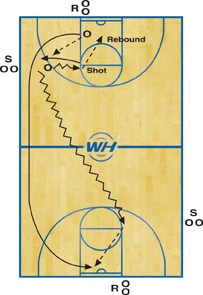‘Turn the Wheel’ drill teaches screens, cuts
Coaches must teach players how to play rather than just teaching them plays. The “Turn the Wheel” drill introduces and reinforces the following basic concepts.

- Setting good screens with a 2-foot stop and a wide base, and hands and arms in a position to protect themselves.
- Setting up those screens and making good shoulder-to-shoulder cuts off of them.
- Understanding the separation principle (screens and cutters can’t always exchange places, and curls, ducks and slips must be utilized or the defense will overplay and switch exchanges).
- Catching the ball and “sweeping” it into triple-threat position.
- Finishing around the rim with power shots (2-foot stops, on balance with shoulders squared to the backboard, shooting using the backboard).
- Passing quickly and accurately.
- Not making two consecutive cuts in the same direction.
DIAGRAM 1: The drill requires five players and two basketballs at a basket with 1 at the top of the key with one ball and two players at each of the wing spots. In this set up, 4 has the second ball and is the second player on the left wing behind 2, while 3 and 5 are on the right wing.
» ALSO SEE: 17-seconds drill develops defensive skills
Limiting the drill to five players helps to keep everyone focused on their specific responsibilities.
DIAGRAM 2: The drill is initiated with a pass and 1 sweeping the ball into triple-threat position, with a U-shaped, two-handed movement to his or her strong shoulder. They then pass to 2, who also sweeps into triple-threat position.
1 then screens away for 3, who curls off the screen and receives a pass from 2 before finishing at the rim with a power shot. 3 collects the rebound and takes it to the left wing behind 4. 2 goes to the top of the key, being careful to leave space for 1 popping back to the original spot.
DIAGRAM 3: As soon as 3 has curled 1’s screen, 1 pops back and receives a pass from 4. 1 then reverses the ball to 5 and makes a basket cut. 5 passes to 1, who finishes at the rim with a power shot.
DIAGRAM 4: 1 rebounds the shot, outlets the ball to 2 and moves to the right wing behind 5. The drill actions are then repeated.
The drill can be adjusted so that the first cutter can duck or go under the screen (DIAGRAM 5), or so the screener can slip the screen and make a basket cut (DIAGRAM 6) with the cutter popping up to the top, reversing the ball and then making a basket (DIAGRAM 7).
Running the drill to the opposite side — putting the second ball in 5’s hands — simply means that the players will rotate to the left rather than to the right (DIAGRAM 8).













